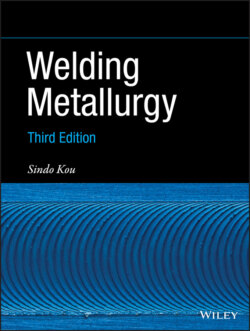Читать книгу Welding Metallurgy - Sindo Kou - Страница 26
1.3.2 Gas–Tungsten Arc Welding 1.3.2.1 The Process
ОглавлениеGTAW is a process that melts and joins metals by heating them with an arc established between a nonconsumable tungsten electrode and the metals, as shown in Figure 1.12. For this reason, welding can be accomplished either with or without a filler metal. When a filler rod is needed, for instance, for joining thicker materials, it can be fed either manually or automatically into the arc. In most other arc welding processes, the electrode itself is a filler wire.
Figure 1.12 Gas–tungsten arc welding: (a) overall process; (b) welding area enlarged.
The torch holding the tungsten electrode is connected to a shielding gas cylinder, as well as one terminal of the power source. The tungsten electrode is usually in contact with a water‐cooled copper tube, called the contact tube, which is connected to the welding cable (cable 1) from the terminal. This allows both the welding current from the power source to enter the electrode and the electrode to be cooled to prevent overheating. The workpiece is connected to the other terminal of the power source through a different cable (cable 2). The shielding gas goes through the torch body and is directed by a nozzle toward the weld pool to protect it from the air.
Protection of the liquid metal is much better in GTAW than in SMAW because an inert gas such as argon or helium is usually used as the shielding gas and because the shielding gas is directed toward the weld pool. For this reason, GTAW is also called tungsten–inert gas (TIG) welding. However, in special uses, a noninert gas can be added in a small quantity to the shielding gas. Therefore, GTAW seems a more appropriate name for this welding process.
